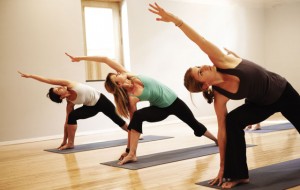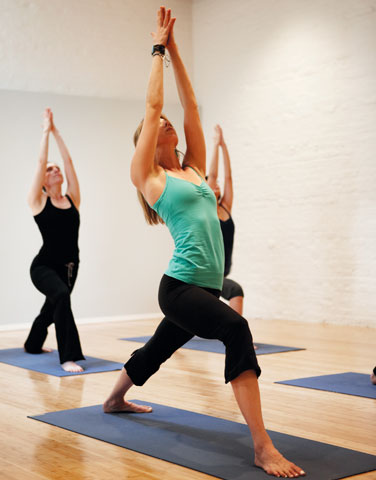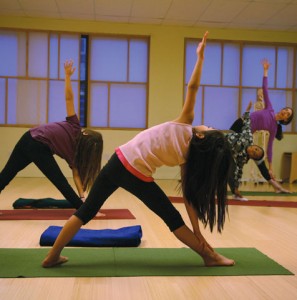Meditating on the Yoga Journal Conference
The Yoga Journal Conference was coming to New York, and as a long-time practitioner and teacher, I thought it was time to check in with the scene and see how American yoga has evolved. I set my alarm for 5:30 a.m., and from the high-flying F train, saw dawn over Brooklyn.
Arriving at the midtown Hilton welcome desk at 7 a.m., I greeted one of my yoga students, a volunteer registering us sleepy mendicants with props slung over our shoulders. I had signed up for six yoga classes in two days. I wondered: Will everyone there be 23, in Lycra, popping into handstands in the middle of the room?
My first 8 a.m. workshop with Dana Flynn allayed those fears. “Do whatever the fuck you want!” she cried. Ah, my kind of gal. Funky music played for us in Radical Movement for Yogis: Unleash the Teacher Within. The feisty, decoratively tattooed Dana — creator of Laughing Lotus — gathered us for her introductory talk. “How many here are teachers?” Hands went up. Then she asked, “What about maintaining your own practice? Do you wait until you’ve finished your list of administrative chores, or do you make sure to take care of yourself?” Got my number! “Do your own practice, first thing! Go deep down inside.” Dana had us dancing through a rhythmic flow of challenging poses. Exhilarated, I relished her exuberant hug. This is what I’ve come for: inspiration, refreshment, an infusion of wisdom.
In the next workshop, the elegant Elena Brower suggested we let the negativity go and release our blame and shame. How often class lectures are addressed to some mood I’m not in. Knowing Elena to be a much-loved teacher, I wondered about the strictures of leading conference classes. As I sat on the floor lengthening over my tired right leg with my left bent in janu sirsasana, an assistant came over to push that bent knee down further. “No!” I said, popping up. After many miles of running, high-impact African dance classes, and years of teaching aerobics, my knees have survived, just. They will descend on their own, thank you. Startled, she breathed a nervous apology.
So many stretches for my already over-stretched hamstrings! Now into my fourth hour of class, I gave up to lie on my back with knees bent. Elena came over sweetly to inquire, and I whispered: “I can’t stretch my hamstrings any more!” With a sympathetic nod, she leaned her body into my bent legs, her weight gently sending my thighbones into my hip joints. I sighed with relief and gratitude.
Gliding up the escalator and along the corridors, with all shapes and sizes and ages, I wondered, “Where are the guys?” Among the mat carriers, I’d seen hundreds of women, two people of color and barely a handful of men. Just past the hastily printed “Women” sign taped to the restroom door was poignant evidence of male absence. Waiting on the inevitable line, I peeked behind the tasteful blue curtain hung along one wall to see, in the shadows, a line of urinals, standing like loyal sentries awaiting their next patrol.
Done at 12:30 with my next class at 3:30, I could see that the schedule was geared for ample time to recover, lunch and shop. I passed through the Marketplace portals to observe the profusion of products and services that have sprouted like weeds around the ancient practice of yoga. There were videos, jewelry, togs and colorful variants on the ubiquitous yoga mat.
“Americans spend $5.7 billion a year on yoga classes and products, including equipment, clothing, vacations and media (DVDs, videos, books and magazines),” says the Yoga Journal page inviting sponsors to do their bit for attendees. “Place your products and services directly in the hands of your best prospects: affluent, health-conscious consumers.” And so they have. Everywhere was someone’s brainchild responding to the trend, iPads poised to snag your precious email address. Here were 50-buck gel discs to cushion tender knees and hands; there were frozen stevia-sweetened coconut bars. I chatted with the sparkly reps offering to make my instructional video. Just inside the entrance was the ultimate shrine to yoga status: white paper background unrolled with a smiling Yoga Journal photog to fulfill your fantasy of being cover girl or boy. Enthusiasts volunteered their most acrobatic pose.
I had brought a change of clothes, anticipating some evening activity — a panel, a kirtan, a party, but no. I was free to stagger home and sink into a hot bath. Before collapsing into slumber, I unpacked my gift bag containing a product for every bodily system: GitOn for my gut, Omegas for my heart, Arnica to heal my bruises, ginseng for my adrenals, melatonin for my sleep, Tea Tree gum for my teeth, antiseptic cream for my skin, Ester-C to buck up my immune system and accelerate my metabolism, fish oil for memory and mood, blueberry pomegranate balm for my lips, a supplement of turmeric, ginger, cayenne and, for my joints, willow bark — hey, isn’t that aspirin? — a Luna bar and coconut milk for a peckish interlude and CleanseMORE for the reluctant digestion that might follow. The notoriously challenging Jivamukti studio distributed free China-Gel for the relief of six different kinds of pain. There was cleansing renewal for my mat, Yogini Cleanies botanically-based body wipes for my sweat (lavender to Zen you out, lemongrass to Zen you up!) and a gold coin from Abacus Wealth Partners, looking suspiciously like Chanukah gelt. Maybe all the spirit is in the accessories.
Eight a.m. on Sunday, I got my first look at the legendary Ana Forrest, known for her athletic, challenging style. Oy, I thought, I’m already zonked. How will I survive?
Out strode this Texas macha wearing weightlifting gloves, exuding the stored kinesis of a jungle cat. “Let’s practice!” Striding around the room, crying out encouragement and flinging her dark waist-length braid with a dramatic flick of the head, Ana was female ferocity made magical. The work deeply warmed my muscles, some moves like physical therapy exercises on a foundation of standing poses. I’m plenty bendy and a little too free in the joints, so the harder we worked, the better I felt. As Ana’s muscled assistants toured the room to help us into arm balances, my fibers screaming for a rest, she counseled, “Stay with it!” Sending us beyond the familiarity of routine, this kind of pain was not the sharp shock of injury, but the weird, burning discomfort of challenging new areas and changing old habits. I realized this is what I need! I’d follow her anywhere.
From there, body buzzing, I went on to the delicate, blonde, balletic fairy princess Natasha Rizopoulos for the workshop Rock the Boat: Navasana and Core Integrity. Many of my students rest one hand on their mid-belly and say, “I have to engage my core,” with little idea of what that means. What, I wondered, would Natasha say of this much-touted and misunderstood zone?
She whipped through a functional anatomy lesson and gave a divinely evolved class on the subject, offering an analysis of the many muscles involved, jumping up to demonstrate with her hyper-mobile slender limbs and crystal clarity. We worked ‘em all — from the deepest tiny muscles joining one vertebra to another, to the abdominals that wrap all the way around to the spine. She, too, asked us to explore whether the mind’s cry to stop came from flagging of the flesh or fatigue of the mind.
When time for home practice is short, she suggests an efficient series of five planks, five boats and a few long prone backbends — shalabhasana. Challenging the popular over-emphasis on the strong rectus abdominis — the fabled “six pack” — as a cure for back problems, to my delight, she articulated the orchestral nature of our musculature — some instruments prevail, but all are playing.
I ended my day with Gary Kraftsow, purveyor of Viniyoga, specializing in adjusting the practice to the person. You will never see a Viniyoga teacher move a crowd through their uniform paces. Viniyogis use asana and meditation to spark change by addressing each person’s unique needs. “Yoga is about transformation of mood, thought and behavior,” he said. “Our intention then becomes stronger than our habit.”
He reflected, in his rabbinical manner and immaculate Sanskrit pronunciation, many years of exploration with a primary branch of yoga: sons of the pioneer Krishnamacharya each created his own approach: Iyengar, Patabbi Jois for Ashtanga and Desikachar into this individualized method. The meaning of the word asana, Gary reminded us, is “seat.” We sat, we listened, we chanted. My mood was, indeed, transformed.
With their theatricality, their love of the crowd, the refined instruction born of deep inner exploration, in these teachers I was seeing the full flower of American yoga, tradition in transit. Even the recent storms reverberating over the contemporary landscape — John Friend’s sex & money scandal, William Broad’s New York Times piece on yoga injuries, the closing of Om Yoga Center in downtown Manhattan — are rumblings in an extraordinary movement with marvelous variety, at its best, awakening us to our higher selves.
The weekend zipped up my practice. For my personal practice, committed as I am to body awareness as a value, opposed to the no-pain-no-gain cliché, I saw the efficacy of effort beyond comfort. When we are well-guided, that burning effort can be therapeutic. I had gone from the funky dancer to the scarred, generous acrobat to the delicate fairy princess to this gentle Hindu scholar whose depth of understanding and whisper of Talmudic tradition — the love of questions, discourse and practice — emerged from the migration of western seekers to eastern wisdom. Looking at these teachers, too seasoned to be young, all with their tales of injury, one sees the alchemy of yoga. Here is this plethora of styles and tones, all called yoga, refined by masters to help us forge ease and understanding on the crucible of universal human suffering. Thus my journey ended, and what a trip it was.
From shallow to profound, from mountaintop to mall, yoga has its charlatans and geeks and giants to nudge us along on our rugged path. As it continues to evolve, this seems to me to be a peak moment, with all the light and shadow of a very lively art.

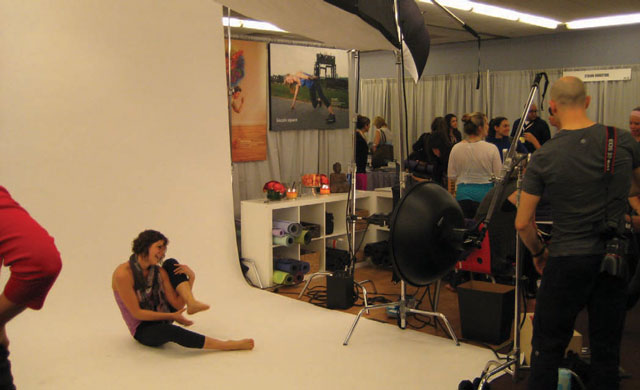
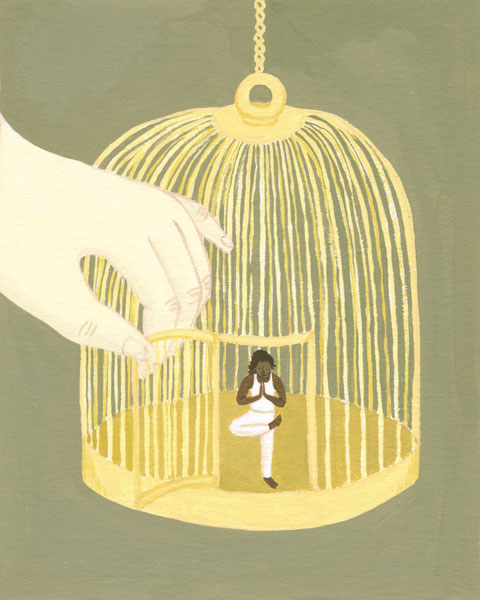 The provocative title of William Broad’s article in the January 8th New York Times Magazine – How Yoga Can Wreck your Body – has a whole nation of yogis buzzing. The news is that people can hurt themselves doing yoga. But they don’t have to. Bring some mindfulness and sound movement principles to your practice, and you greatly reduce your chance of injury.
The provocative title of William Broad’s article in the January 8th New York Times Magazine – How Yoga Can Wreck your Body – has a whole nation of yogis buzzing. The news is that people can hurt themselves doing yoga. But they don’t have to. Bring some mindfulness and sound movement principles to your practice, and you greatly reduce your chance of injury.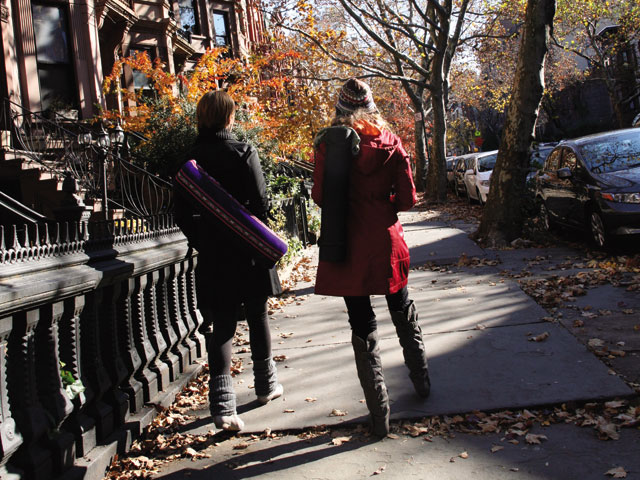 It’s a wet Friday night in Manhattan. Through my apartment window, thick raindrops sound like bullets as they ricochet off the conditioner and scare the pigeons away. My phone rings. It’s my editor. He says he has an idea for a story about Park Slope, how “it’s the new Yoga hub of the metropolitan area,” and he wants me to do the footwork, and check it out.
It’s a wet Friday night in Manhattan. Through my apartment window, thick raindrops sound like bullets as they ricochet off the conditioner and scare the pigeons away. My phone rings. It’s my editor. He says he has an idea for a story about Park Slope, how “it’s the new Yoga hub of the metropolitan area,” and he wants me to do the footwork, and check it out.